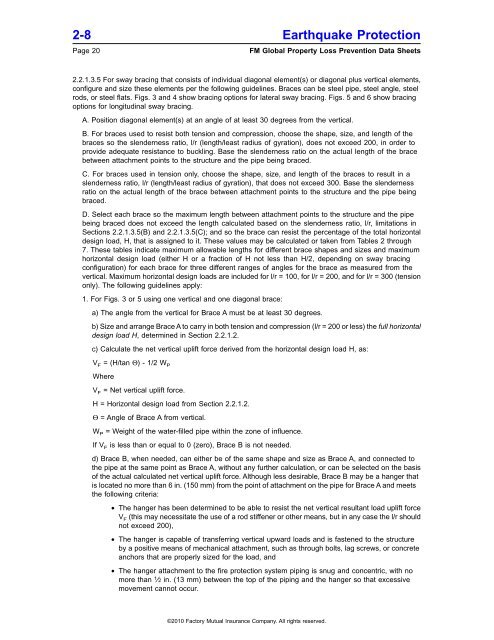DS 2-8 Earthquake Protection for Water-Based Fire ... - FM Global
DS 2-8 Earthquake Protection for Water-Based Fire ... - FM Global
DS 2-8 Earthquake Protection for Water-Based Fire ... - FM Global
You also want an ePaper? Increase the reach of your titles
YUMPU automatically turns print PDFs into web optimized ePapers that Google loves.
2-8 <strong>Earthquake</strong> <strong>Protection</strong><br />
Page 20 <strong>FM</strong> <strong>Global</strong> Property Loss Prevention Data Sheets<br />
2.2.1.3.5 For sway bracing that consists of individual diagonal element(s) or diagonal plus vertical elements,<br />
configure and size these elements per the following guidelines. Braces can be steel pipe, steel angle, steel<br />
rods, or steel flats. Figs. 3 and 4 show bracing options <strong>for</strong> lateral sway bracing. Figs. 5 and 6 show bracing<br />
options <strong>for</strong> longitudinal sway bracing.<br />
A. Position diagonal element(s) at an angle of at least 30 degrees from the vertical.<br />
B. For braces used to resist both tension and compression, choose the shape, size, and length of the<br />
braces so the slenderness ratio, l/r (length/least radius of gyration), does not exceed 200, in order to<br />
provide adequate resistance to buckling. Base the slenderness ratio on the actual length of the brace<br />
between attachment points to the structure and the pipe being braced.<br />
C. For braces used in tension only, choose the shape, size, and length of the braces to result in a<br />
slenderness ratio, l/r (length/least radius of gyration), that does not exceed 300. Base the slenderness<br />
ratio on the actual length of the brace between attachment points to the structure and the pipe being<br />
braced.<br />
D. Select each brace so the maximum length between attachment points to the structure and the pipe<br />
being braced does not exceed the length calculated based on the slenderness ratio, l/r, limitations in<br />
Sections 2.2.1.3.5(B) and 2.2.1.3.5(C); and so the brace can resist the percentage of the total horizontal<br />
design load, H, that is assigned to it. These values may be calculated or taken from Tables 2 through<br />
7. These tables indicate maximum allowable lengths <strong>for</strong> different brace shapes and sizes and maximum<br />
horizontal design load (either H or a fraction of H not less than H/2, depending on sway bracing<br />
configuration) <strong>for</strong> each brace <strong>for</strong> three different ranges of angles <strong>for</strong> the brace as measured from the<br />
vertical. Maximum horizontal design loads are included <strong>for</strong> l/r = 100, <strong>for</strong> l/r = 200, and <strong>for</strong> l/r = 300 (tension<br />
only). The following guidelines apply:<br />
1. For Figs. 3 or 5 using one vertical and one diagonal brace:<br />
a) The angle from the vertical <strong>for</strong> Brace A must be at least 30 degrees.<br />
b) Size and arrange Brace A to carry in both tension and compression (l/r = 200 or less) the full horizontal<br />
design load H, determined in Section 2.2.1.2.<br />
c) Calculate the net vertical uplift <strong>for</strong>ce derived from the horizontal design load H, as:<br />
V F = (H/tan Θ) - 1/2 W P<br />
Where<br />
V F = Net vertical uplift <strong>for</strong>ce.<br />
H = Horizontal design load from Section 2.2.1.2.<br />
Θ = Angle of Brace A from vertical.<br />
W P = Weight of the water-filled pipe within the zone of influence.<br />
If V F is less than or equal to 0 (zero), Brace B is not needed.<br />
d) Brace B, when needed, can either be of the same shape and size as Brace A, and connected to<br />
the pipe at the same point as Brace A, without any further calculation, or can be selected on the basis<br />
of the actual calculated net vertical uplift <strong>for</strong>ce. Although less desirable, Brace B may be a hanger that<br />
is located no more than 6 in. (150 mm) from the point of attachment on the pipe <strong>for</strong> Brace A and meets<br />
the following criteria:<br />
• The hanger has been determined to be able to resist the net vertical resultant load uplift <strong>for</strong>ce<br />
V F (this may necessitate the use of a rod stiffener or other means, but in any case the l/r should<br />
not exceed 200),<br />
• The hanger is capable of transferring vertical upward loads and is fastened to the structure<br />
by a positive means of mechanical attachment, such as through bolts, lag screws, or concrete<br />
anchors that are properly sized <strong>for</strong> the load, and<br />
• The hanger attachment to the fire protection system piping is snug and concentric, with no<br />
more than 1 ⁄ 2 in. (13 mm) between the top of the piping and the hanger so that excessive<br />
movement cannot occur.<br />
©2010 Factory Mutual Insurance Company. All rights reserved.

















